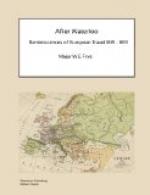We arrived at Terni at three o’clock and immediately hired a caleche (the other travellers and myself) to visit the famous cascade of the Velino, about three miles distant from the town of Terni. The road thither is very rugged, and is a continual ascent on the flank of a ravine. For a long time before you arrive on the brink of the cascade, you hear the roaring of the waters; and it certainly is the most magnificent and awe-inspiring sight of the kind I ever beheld. It is far more stupendous than any cascade in Switzerland. That of Tivoli compared to it is as an infant six months old to a Goliath. The Velino forms three successive falls, and the last is tremendous, since it falls from a height of 1,068 feet into the abyss below. The foam and the froth it occasions is terrific; and the spray ascends so high that in standing at the distance of fifty yards from the fall you become as wet as if you had been standing in a shower of rain. The first fall it forms is of 800 feet; the second little less; the third I have stated already. No painting can possibly give a faithful delineation of this, and very possibly no poetic description can give an adequate idea thereof. We passed the whole night at Terni and the next morning we stopped to dine at Spoleto. The same evening we arrived at Foligno. Spoleto is a neat town and well paved. Several ruins of ancient buildings are in its vicinity. Before you arrive there, on the left of the road, is an immensely high two-arched bridge. There is an aqueduct likewise just outside the town. We did not omit to read the inscription on the gate of the town, in commemoration of the repulse of Hannibal, who failed in his attempt to make himself master of this city, after having beat the Romans near the lake Trasymene. The gate is called in consequence Porta Fugae, and this gate constitutes the principal glory of Spoleto. We were shown the rums of a Palace built by Theodoric. On leaving the town, just outside the gate, we were shewn a bridge which had laid underground for many centuries and had been lately discovered. A bridge was known to have been built here in the time of Augustus, and it is very probably the identical one; we could only see the top and part of the parapet.
Foligno is a large, well built city, neatly paved, populous and commercial, renowned for manufactories of paper, wax, and confectionary.




